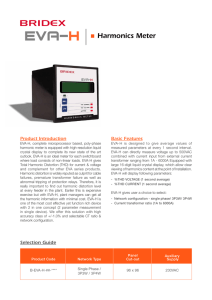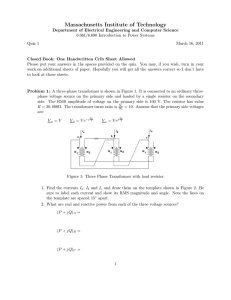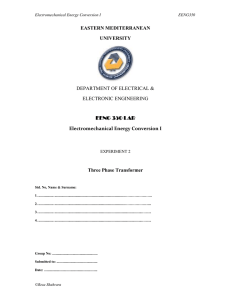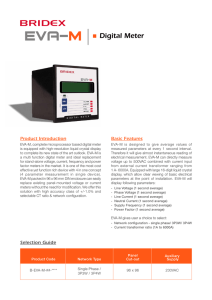Design of Unified Power Quality Conditioner (UPQC) to
advertisement
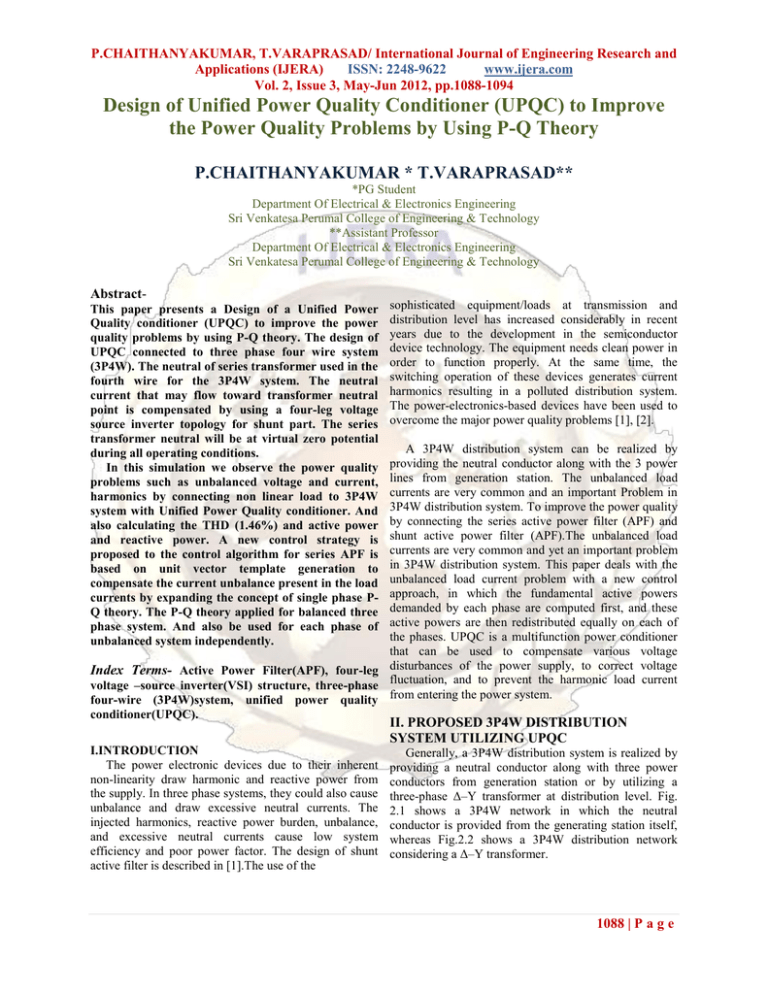
P.CHAITHANYAKUMAR, T.VARAPRASAD/ International Journal of Engineering Research and Applications (IJERA) ISSN: 2248-9622 www.ijera.com Vol. 2, Issue 3, May-Jun 2012, pp.1088-1094 Design of Unified Power Quality Conditioner (UPQC) to Improve the Power Quality Problems by Using P-Q Theory P.CHAITHANYAKUMAR * T.VARAPRASAD** *PG Student Department Of Electrical & Electronics Engineering Sri Venkatesa Perumal College of Engineering & Technology **Assistant Professor Department Of Electrical & Electronics Engineering Sri Venkatesa Perumal College of Engineering & Technology AbstractThis paper presents a Design of a Unified Power Quality conditioner (UPQC) to improve the power quality problems by using P-Q theory. The design of UPQC connected to three phase four wire system (3P4W). The neutral of series transformer used in the fourth wire for the 3P4W system. The neutral current that may flow toward transformer neutral point is compensated by using a four-leg voltage source inverter topology for shunt part. The series transformer neutral will be at virtual zero potential during all operating conditions. In this simulation we observe the power quality problems such as unbalanced voltage and current, harmonics by connecting non linear load to 3P4W system with Unified Power Quality conditioner. And also calculating the THD (1.46%) and active power and reactive power. A new control strategy is proposed to the control algorithm for series APF is based on unit vector template generation to compensate the current unbalance present in the load currents by expanding the concept of single phase PQ theory. The P-Q theory applied for balanced three phase system. And also be used for each phase of unbalanced system independently. sophisticated equipment/loads at transmission and distribution level has increased considerably in recent years due to the development in the semiconductor device technology. The equipment needs clean power in order to function properly. At the same time, the switching operation of these devices generates current harmonics resulting in a polluted distribution system. The power-electronics-based devices have been used to overcome the major power quality problems [1], [2]. A 3P4W distribution system can be realized by providing the neutral conductor along with the 3 power lines from generation station. The unbalanced load currents are very common and an important Problem in 3P4W distribution system. To improve the power quality by connecting the series active power filter (APF) and shunt active power filter (APF).The unbalanced load currents are very common and yet an important problem in 3P4W distribution system. This paper deals with the unbalanced load current problem with a new control approach, in which the fundamental active powers demanded by each phase are computed first, and these active powers are then redistributed equally on each of the phases. UPQC is a multifunction power conditioner that can be used to compensate various voltage Index Terms- Active Power Filter(APF), four-leg disturbances of the power supply, to correct voltage voltage –source inverter(VSI) structure, three-phase fluctuation, and to prevent the harmonic load current four-wire (3P4W)system, unified power quality from entering the power system. conditioner(UPQC). II. PROPOSED 3P4W DISTRIBUTION SYSTEM UTILIZING UPQC I.INTRODUCTION The power electronic devices due to their inherent non-linearity draw harmonic and reactive power from the supply. In three phase systems, they could also cause unbalance and draw excessive neutral currents. The injected harmonics, reactive power burden, unbalance, and excessive neutral currents cause low system efficiency and poor power factor. The design of shunt active filter is described in [1].The use of the Generally, a 3P4W distribution system is realized by providing a neutral conductor along with three power conductors from generation station or by utilizing a three-phase Δ–Y transformer at distribution level. Fig. 2.1 shows a 3P4W network in which the neutral conductor is provided from the generating station itself, whereas Fig.2.2 shows a 3P4W distribution network considering a Δ–Y transformer. 1088 | P a g e P.CHAITHANYAKUMAR, T.VARAPRASAD/ International Journal of Engineering Research and Applications (IJERA) ISSN: 2248-9622 www.ijera.com Vol. 2, Issue 3, May-Jun 2012, pp.1088-1094 Assume a plant site where three-phase three-wire UPQC is already installed to protect a sensitive load and to restrict any entry of distortion from load side toward utility, as shown in Fig.2.3. If we want to upgrade the system now from 3P3W to 3P4W due to installation of some single-phase loads and if the distribution transformer is close to the plant under consideration, utility would provide the neutral conductor from this transformer without major cost involvement. Fig 2. 1: 3P4W distribution system: neutral provided from generation station. Fig 2.2 : 3P4W distribution system: neutral provide from transformer. Fig 2.3: 3P3W UPQC structure. Recently, the utility service providers are putting function as a controlled voltage source. If we could use more and more restrictions on current total harmonic the neutral of three-phase series transformer to connect a distortion (THD) limits, drawn by nonlinear loads, to neutral wire to realize the 3P4W system, then 3P4W control the power distribution system harmonic system can easily be achieved from a 3P3W system (Fig. pollution. At the same time, the use of sophisticated 2.4). The neutral current, present if any, would flow equipment/load has increased significantly, and it needs through this fourth wire toward transformer neutral clean power for its proper operation. Therefore, in future point. This neutral current can be compensated by using distribution systems and the plant/load centers, a split capacitor topology [2], [9], [10] or a four-leg application of UPQC would be common. Fig.2. 4 shows voltage-source inverter (VSI) topology for a shunt the proposed novel 3P4W topology that can be realized inverter [2], [11]. from a 3P3W system. This proposed system has all the advantages of general UPQC, in addition to easy In this paper, the four-leg VSI topology is expansion of 3P3W system to 3P4W system. considered to compensate the neutral current flowing toward the transformer neutral point. A fourth leg is Thus, the proposed topology may play an important added on the existing 3P3W UPQC, such that the role in the future 3P4W distribution system for more transformer neutral point will be at virtual zero potential. advanced UPQC based plant/load center installation, Thus, the proposed structure would help to realize a where utilities would be having an additional option to 3P4W system from a 3P3W system at distribution load realize a 3P4W system just by providing a 3P3W supply. end. This would eventually result in easy expansion from As shown in Fig.2.3, the UPQC should necessarily 3P3W to 3P4W systems. consist of three-phase series transformer in order to connect one of the inverters in the series with the line to 1089 | P a g e P.CHAITHANYAKUMAR, T.VARAPRASAD/ International Journal of Engineering Research and Applications (IJERA) ISSN: 2248-9622 www.ijera.com Vol. 2, Issue 3, May-Jun 2012, pp.1088-1094 Fig 2.4: Proposed 3P4W system realized from a 3P3W system utilizing UPQC. III.DESIGN OF UPQC CONTROLLER = (3.4) The control algorithm for series APF is based on unit vector template generation scheme [8].Where as the control strategy for shunt APF is discussed in this In addition, for phase c, the load voltage and current in section. Based on the load on the 3P4W system, the α–β coordinates can be represented by π/2 lead as current drawn from the utility can be unbalanced. In this paper, the concept of single phase P-Q theory [9], [10]. = = According to this theory, a single phase system can be defined as a pseudo two-phase system by giving π/2 lead (3.5) or π /2 lag that is each phase voltage and current of the original three phase systems. = (3.6) These resultant two phase systems can be represented in α-β coordinates, and thus P-Q theory applied for balanced three phase system [11] can also be used for each phase of unbalanced system independently. The actual load voltages and load currents are considered as α-axis quantities, whereas the π/2 lead load or π/2 lag voltages and π/2 lead or π/2 lag load currents are considered as β-axis quantities. In this paper, π/2 lead is considered to achieve a two-phase system for each phase. The major disadvantage of p–q theory is that it gives poor results under distorted and/or unbalanced input/utility voltages [4], [5]. In order to eliminate these limitations, the reference load voltage signals extracted for series APF are used instead of actual load voltage. For phase a, the load voltage and current in α–β coordinates can be represented by π/2 lead as = = = (3.1) By using the definition of three-phase p–q theory for balanced three-phase system [3], the instantaneous power components can be represented as Instantaneous active power = (3.7) Instantaneous reactive power = (3.8) Considering phase a, the phase-a instantaneous load active and instantaneous load reactive powers can be represented by = Where (3.9) = + (3.10) = + (3.11) (3.2) In (3.10) and (3.11), and represent the dc components that are responsible for fundamental load Where represents the reference load voltage and active and reactive powers, whereas and represent represents the desired load voltage magnitude. the ac components that are responsible for harmonic powers. The phase-a fundamental instantaneous load Similarly, for phase b, the load voltage and current in active and reactive power components can be extracted from and , respectively, by using a low pass α–β coordinates can be represented by π/2 lead as filter. = = Therefore, the instantaneous fundamental load active and reactive power for phase a is given by (3.3) = (3.12) 1090 | P a g e P.CHAITHANYAKUMAR, T.VARAPRASAD/ International Journal of Engineering Research and Applications (IJERA) ISSN: 2248-9622 www.ijera.com Vol. 2, Issue 3, May-Jun 2012, pp.1088-1094 since the utility should not supply load reactive power demand. In the above matrix, the α- axis reference Similarly, the fundamental instantaneous load active and compensating current represents the instantaneous fundamental source current, since α-axis quantities reactive powers for phase b is given by belong to the original system under consideration and the = (3.14) β-axis reference compensating current represents the = (3.15) current that is at π/2 lead with respect to the original system. Therefore, Instantaneous fundamental load active and reactive = (3.21) power for phase c = (3.16) Similarly, the reference source current for phases b and c can be estimated as = (3.17) = (3.22) = (3.13) Since the load current drawn by each phase may be different due to different loads that may be present inside plant, therefore, the instantaneous fundamental load active power and reactive power demand for each phase may not be the same. In order to make this load unbalanced power demand, seen from the utility side, as a perfectly balanced fundamental three-phase active power the unbalanced load power should be properly redistributed between utility, UPQC, and load, such that the total load seen by the utility would be linear and balanced load. The unbalanced or balanced reactive power demanded by the load should be handled by a shunt APF. The aforementioned task can be achieved by summing instantaneous fundamental load active power demands of all the three phases and redistributing it again on each utility phase, i.e., from (3.12), (3.14), and (3.16), = + + (3.18) = (3.19) Equation (3.19) gives the redistributed per-phase fundamental active power demand that each phase of utility should supply in order to achieve perfectly balanced source currents. From (3.19), it is evident that under all the conditions, the total fundamental power drawn from the utility but with perfectly balanced way even though the load currents are unbalanced. Thus, the reference compensating currents representing a perfectly balanced three-phase system can be extracted by taking the inverse of (3.9) = (3.23) The reference neutral current signal can be extracted by simply adding all the sensed load currents, without actual neutral current sensing, as = (3.24) = (3.25) The proposed balanced per-phase fundamental active power estimation, dc-link voltage control loop based on PI regulator, the reference source current generation as given by (3.21)–(3.23),and the reference neutral current generation are shown in Fig 4.3 to Fig 4.7, respectively. IV. SIMULATION RESULTS The simulation results for the proposed 3P4W system realized from a 3P3W system utilizing UPQC are shown in below figures 4.2 to 4.10.Utility voltage are assumed to be distorted with voltage THD of 14.03 % is shown in Figure.4.7.The distorted voltage profile is shown in figure.4.2(A). The resulting load current profile shown in figure.4.4 (B) has THD of 12.10% in Figure.6.10. The UPQC should maintain the voltage at load bus at a desired value and free from distortion. The plant load is assumed to be the combination of a balanced threephase diode bridge rectifier followed by an R-L load, which acts as a harmonic generating load, and three different single-phase loads on each phase, with different = (3.20) load active and reactive power demands. The shunt APF is turned on first at time t=0.1sec, such that it maintains the dc-link voltage at a set reference value, here In (3.20), is the precise amount of per-phase V=220V.At time t=0.2sec (is shown in figure.4.). active power that should be taken from the source in The series active power filter injects the required order to maintain the dc-link voltage at a constant level compensating voltages through series transformer, and to overcome the losses associated with UPQC. The making the load voltage free from distortion (THD = oscillating instantaneous active power should be 1.46%) and at a desired level as shown in figure.4.2 (B) exchanged between the load and shunt APF. The in load voltage. The series active power filter injected reactive power term ( ) in (3.20) is considered as zero, voltage profile is shown in figure.4.2(C). 1091 | P a g e P.CHAITHANYAKUMAR, T.VARAPRASAD/ International Journal of Engineering Research and Applications (IJERA) ISSN: 2248-9622 www.ijera.com Vol. 2, Issue 3, May-Jun 2012, pp.1088-1094 The compensated source currents shown in figure.4.4 (A) are perfectly balanced with the THD of 2.26% is shown in figure 4.9 .The compensating current injected through the fourth leg of the shunt APF is shown in figure.4.4(C).The load neutral current profile is shown in figure.4.5 and figure.4.6.In figure.4.3, the shunt APF effectively compensates the current flowing toward the transformer neutral point. Thus, the series transformer neutral point is maintained at virtual zero potential is shown in figure 4.3(B). Figure.4.1 Simulation Block Diagram of 3P4W system realized from a 3P3W system utilizing UPQC. Figure.4.2: (A) Utility Voltage (Vs_abc), (B) Load Voltage (Vl_abc) and (C) Injected Voltage (Vinj_abc). Figure.4.4 (A) Source Current (Is_abc), (B) Load Current (Il_abc) and (C) Shunt Compensating Current (Ish_abc). Figure.4.5: Shunt neutral compensating current (i Sh_n). Figure.4.3 :( A) Dc-link voltage (vdc), and (B) neutral current flowing towards series transformer (i Sr_n). Figure.4.6: Current flowing through load neutral wire (iL_n). 1092 | P a g e P.CHAITHANYAKUMAR, T.VARAPRASAD/ International Journal of Engineering Research and Applications (IJERA) ISSN: 2248-9622 www.ijera.com Vol. 2, Issue 3, May-Jun 2012, pp.1088-1094 Figure.4.8: Load Voltage THD=1.46%. Figure.4.7: Distorted Voltage THD = 14.03%. Figure.4.10: Load Current THD = 12.10%. Figure.4.9: Source Current THD = 2.26%. V. CONCLUSION The design of a unified power quality conditioner (UPQC) connected to 3P4W distribution system has been presented in this project. Where upqc is installed to compensate the different power quality problems, which may play an important role in future upqc based distribution system. The simulation results shows that the distorted and unbalanced load currents seen from the utility side act as perfectly balanced source currents and are free from distortion. Here we can absorb the power quality problems like voltage and current unbalanced and reduced the total harmonic distortion (THD) of 3P4W system utilizing 3P3W system to connect the UPQC. The neutral current that may flow toward the transformer neutral point is effectively compensated such that the transformer neutral point is always at virtual zero potential. Proposed model for the UPQC is to compensate input voltage harmonics and current harmonics caused by non-linear load. The work can be extended to compensate the supply voltage and load current imperfections such as sags, swells, interruptions, voltage imbalance, flicker, and current unbalance. Proposed UPQC can be implemented using Multi converterunified power quality conditioning system (MC-UPQC). REFERENCES [1] Vinod khadkikar, Ambrish Chandra, “A novel structure for three-phase four-wire distribution system utilizing unified power quality conditioner(UPQC),” IEEE Transaction on industry application ,Vol.45,no.5,pp.18971902,Sep/oct.2009. [2] B. Singh, K. Al-Haddad, and A. Chandra, “A review of active power filters for power quality improvement,” IEEE Trans. Ind. Electron., vol. 45, no. 5, pp. 960–971, Oct. 1999. [3] Y.Komatsu and T.Kawabata, “A Control method of active power filter in unsymmetrical and distorted voltage system,” in proc.Conf.IEEE Power Convers. 1997, vol.1, pp.161-168. [4] C. A. Quinn and N. Mohan, “Active filtering of harmonic currents in three-phase, fourwire systems with three-phase and single-phase nonlinear loads,” in Proc. 7th IEEE APEC, 1992, pp. 829– 836. [5] M.Aredes, K.Heumann, and E.h.Watanabe, “An universal active power line conditioner,” IEEE Trans. power Del., vol.13, no.2, pp.542551,Apri.1998. [6] R. Faranda and I. Valade, “UPQC compensation strategy and design aimed at reducing losses,” in Proc. IEEE ISIE, 2002, vol. 4, pp. 1264–1270. [7] G. Chen, Y. Chen, and K. M. Smedley, “Threephase four-leg active power quality conditioner without references calculation,” in Proc. 19th IEEE APEC, 2004, vol. 1, pp. 829–836. [8] V.Khadkikar, A. Chandra, A.O.Barry, and T.D.Nguyen, “Application of UPQC to protect a sensitive load on a polluted distribution network,” in proc.IEEE PES General Meeting. Montreal, QC, Canada, 2006, 6 pp. 1093 | P a g e
